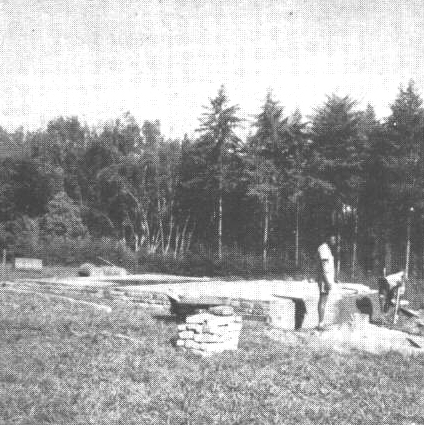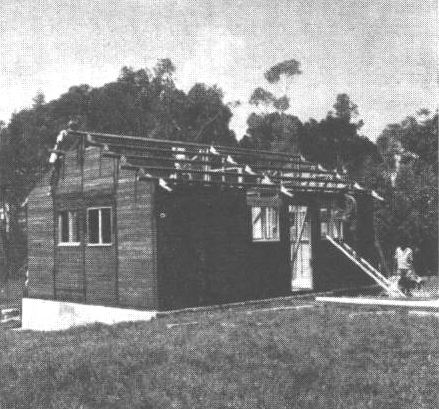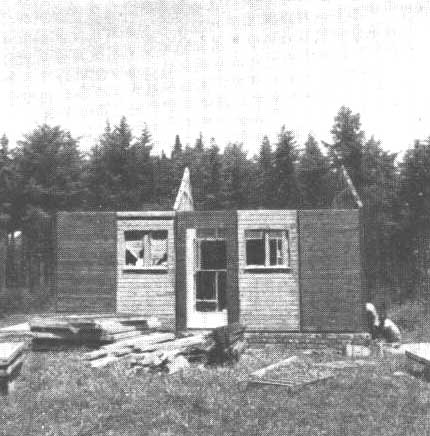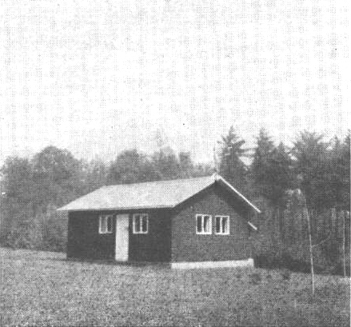Australia
Canada
Cuba
Fiji
Gambia
Japan
Jordan
Libya
Mauritius
Ruanda Urundi
Tristan da Cunha
United Kingdom
United States of America
· The Natural Regeneration of Eucalyptus Regnans (T. M. Cunningham, Bulletin No. 1, School of Forestry, University of Melbourne, 158 pp., 1960) is a comprehensive study of the problem of natural regeneration of Eucalyptus regnans forests after logging. The author has investigated seed production and dispersal, the fate of the dispersed seed particularly with regard to insect losses, and the factors affecting seed germination and seedling survival. He has tested methods of prelogging seedbed preparation and of partial cutting to obtain regeneration. He recommends, in addition, spraying to control seedrobbing insects, and the use of artificial regeneration methods to plant nursery-raised seedlings in those areas where natural regeneration has proved to be inadequate.
The forestry school of Sopron, in northwest Hungary, graduated its last class at Vancouver in May, thousands of miles from its original home. The unveiling of a plaque at International House on the campus of the University of British Columbia marked the end of a dramatic story that began in November 1956. When the last sparks of the Hungarian revolt were extinguished, the entire teaching staff and student body of the forestry school, one of the best in Europe, crossed into Austria.
Early in 1957, under the sponsorship of the Canadian Government, the entire school sailed for Canada. It included 196 students, averaging 20 years in age, 12 of them girls, and 29 faculty members. There were also 21 members of the teaching staff, wives, and 50 children. In spite of language and financial difficulties, the school prospered in Vancouver.
Twenty-three students were in this year's final graduating class, bringing the total of graduates to 139. Of the 116 who had already graduated, 100 are now in forestry work, 90 of them in British Columbia. Of the teaching staff, four remain. Some of the others have transferred to other faculties, or are with other universities in North America. Some are in forest research. A few are engaged as mining or forest engineers. Of the students who dropped out of the school, eight returned to Hungary.
· Four species of pine occur in Cuba - Pinus caribaea and P. tropicalis in the west, P. cubensis and P. occidentalis in the east, the two groups being some 1,000 kilometers apart. The species themselves tend to be isolated into monospecific stands, mostly associated with the montane zones at elevations of up to 1,000 meters of more. Both caribaea and cubensis, however, also occur down to near sea level. All four species show an unusually high proportion of straight-stemmed, light-branched trees.
Climatically, the forests enjoy good rainfall, 1,450 to 2,000 millimeters, well distributed, with one rainy season May to November. Relative humidity averages 75 percent, temperatures we tropical. Soils vary considerably, in both origin and character, from the ferruginous clays of the Sierra de Nipe to the shallow sandy loams over phyllite in the west.
Most of the pine forests have been heavily exploited in the past but more recently they have been brought firmly under protective control, including the prohibition of burning, and a start has been made on reforestation. The forest department is at present using mainly P. caribaea in the form of polythene- potted nursery stock for its planting programs. This work is being aided by the creation of national parks in certain of the more accessible and picturesque forest zones.
· The United Kingdom has made a grant totaling U. S. S 29,300 for a research project designed to help Fiji's timber resources. Fiji has a wide range of timbers, but more scientific and technical knowledge is needed about their properties in order that they may be developed to the best advantage.
A timber research unit will be set up in the colony to carry out investigations and make tests locally. In addition it will prepare samples of different species of timber to send to the Commonwealth Scientific and Industrial Research Organization in Melbourne for more detailed scientific examination.
· An interesting development in 1960 was the introduction of a slightly modified taungya intercropping trial in N'Yambai forest park, which gave extremely satisfactory results. The crops employed were groundnuts and upland rice.
Initially, public response was poor to the invitation to farm between the newly planted trees - a basic 7 x 7 feet (2 x 2 meters) admixture of Gmelina arborea, Albizzia lebbek and Khaya senegalensis introduced species for field trials at very wide espacement in rows 49 feet (15 meters) apart. It was believed that damage by monkeys and other wildlife within the forest park would preclude attempts to grow crops.
Fortunately, however, enough interested farmers were eventually forthcoming to enable 25 acres (10 hectares) of intercropping with groundnuts and the equivalent area with upland rice. Despite the late sowing a better than average harvest was enjoyed from both crops.
· A nation-wide forest tree breeding project started after the last war. Before that time, some interested foresters had undertaken a limited amount of work on selection of elite breeding stock for various species, and research had been developed in the forest experiment stations and universities.
In 1952 a Forest Tree Breeding Association was established and in the same year, Professor Bertil Lindquist of Sweden visited Japan in order to promote interest in forest tree breeding. Since 1954, the selection of elite trees has spread in the national forests and in some prefectures, and at the same time tree breeding research institutes have been established by private organizations. From 1957, government subsidies have enabled all prefectures to proceed with the selection of elite trees, and as a result, nearly 6,000 elite or plus trees have been identified.
Nine government tree breeding stations have now been established, distributed over the country according to the site, climatic and other conditions. Their task is to carry out progeny tests and to produce now superior species through the media of mother material of elite trees of both indigenous and exotic species. Seed or tree orchards for the propagation of superior seeds and seedlings are established in each forest region and district in all prefectures, to supply better seed and planting stock for the national forests, to dealers in seed and plants, and to forest owners' associations.
· The northern forest zone in Jordan is both actually and potentially the forest area of greatest productivity, and lies nearest the main centers of population. The forests lying in the south of Jordan, which are more heavily exploited and will require a rather long period to rehabilitate, are furthest from the main population concentrations.
The northern forests lie on the hills to the east of the River Jordan and comprise the whole of the pine forests of the country together with associated areas of mixed hardwood forest (mainly oak) and areas of forest scrub and maquis. The area covered by these forests is estimated at 134,000 hectares, which represents about one quarter of the land classified as forest tree-bearing, but these figures we only rough estimates pending the forest inventory which will give precise figures for the land under various tree crops.
The forests have been overexploited, overgrazed and are in general in very poor condition. Much of the earlier exploitation occurred at the time when the forests provided the fuelwood for the Hejaz railway. Since the end of the first world war the forests have not been exploited for this purpose, but they have nevertheless been seriously overcut by the local population for fuelwood and poles. Moreover, the forests have not been allowed to regenerate properly, since the tribesmen living in the area maintain large flocks of goats.
Within relatively recent times the Government of Jordan has taken steps to conserve the remaining forest land. Illicit cuttings have now been brought under control and grazing has been excluded from the main pine forests. The consequent recovery of these forests, with good natural regeneration, has been quite remarkable.
The Forest Department is also responsible for range management and, in view of the serious livestock problem, a dual forestry/range management approach to the vegetation conservation problems of the country has been developed.
Local fellings in the forests amount to approximately 90,000 cubic meters annually, of which a mere 3,700 cubic meters consist of industrial wood, the remainder being fuelwood and wood for charcoal. The supply of the latter is sufficient to meet local demand, but the bulk of the industrial wood consumed still has to be imported. Imports of industrial wood have been steadily increasing, and today amount annually to about 100,000 cubic meters of roundwood, representing a value of more than U.S. 8 4 million. However, even with this heavy burden of imports the country's wood consumption amounts to only 55 cubic meters per 1,000 inhabitants, which is only half of the average of the Near East and one tenth of the world average. With a population increase of 1.6 percent in the past, but expected to increase to 3 percent, and the Government's decided policy to raise standards of living, consumption of wood will increase substantially. Since a concomitant increase in imports is excluded, the Government has no alternative but to develop the indigenous forest resources in order to cope with future requirements. It has decided to face this challenge.
· The Jebel Akhdar area of northern Cyrenaica supports the best forest stands in Libya, and has the highest rainfall in the country. The main forest area forms the highest plateau in Cyrenaica., having a mean elevation of 600 meters above sea level and is almost entirely timber land.
The dominant feature of the central sector of this area is a cypress forest peculiar to subhumid zones (rainfall 450 to 650 millimeters). Associated with cypress (Cupressus sempervirens) in great abundance are oak (Quercus coccifera) and juniper (Juniperus phoenicea), together with olive (O. eaoleaster), Pistacia lentiscus and carob (Ceratonia siliqua). The total area of forest is about 60,000 hectares and the trees vary from 20 to 25 meters in height. This central sector is surrounded by about 100,000 hectares of more open juniper woodland associated with Pistacia, olive and Arbutus. In a few places this woodland can be regarded as true forest, in others it is better termed maquis.
On a lower plateau lying to the north and east of the former, is another area of forest with the rainfall varying from 300 to 550 millimeters. It is estimated that within this area are some 10,000 hectares of closed forest and about 130,000 hectares of more open woodland. Tree species occurring in this area include juniper, oak, cypress and a certain amount of pine (Pinus halepensis).
Some agricultural settlements remain from the 1930's, but planned development of the region since the end of the second world war has been hampered by the lack of knowledge of the natural resources of the area. With the recent successful search for oil in Libya, it is anticipated that the revenue of the country will be substantially increased from 1963 onward. The Libyan Government has formed a development council to administer the bulk (70 percent) of the oil revenues and plans to use this money for permanent development projects. Since the inhabitants are mainly pastoral, the part to be played by agriculture in the future development of the country will be considerable.
· Very severe damage was caused to the island by the two cyclones "Alix" (19 January 1960) and "Carol" (28 February 1960).
The damage caused by "Alix," the milder of the two cyclones, was restricted mainly to Eucalyptus plantations, particularly in the upland regions, while coniferous crops and plantations of other species suffered remarkably little damage.
The rehabilitation of Eucalyptus plantations has gone hand-in-hand with the exploitation of poles for the reconstruction of houses blown down, and at the close of December 1960 approximately 900,000 poles had been cut and distributed or sold.
The second cyclone "Carol" passed directly over the island from north to south and was the most intense ever recorded in these regions. It was accompanied by winds of a maximum velocity exceeding 175 m.p.h. (280 km/h) and spared little. Owing to delayed action deaths in tree crops, it has not yet been possible finally to assess total damage in plantations, but approximately 2,000 acres (800 hectares) of pine plantations of 12 years of age and over were virtually destroyed, leaving an estimated 1,500,000 cubic feet (42,000 cubic meters) of timber to be harvested without delay. An unusual feature of the damage was that the vast majority of the older pine trees were broken at varying heights from the ground, few having been blown down. In past cyclones the number of blown down trees exceeded by far those which were broken by the force of the winds.
Damage to the indigenous forests was unusually severe in many places, where large numbers of the older and mature trees were blown down or broken at varying heights from the ground, leaving gaps in a canopy which was previously closed. Delayed action deaths were also becoming increasingly apparent some ten months after the cyclones. Severe damage in the indigenous forests has been unknown in the past.
The coastal Casuarina plantations, which suffered little from "Alix," were destroyed by "Carol." Initial assessments of damage appeared to indicate that damage, though severe, was not crippling, but the accumulating effects of delayed action deaths have made it apparent that approximately 80 percent of the Casuarina plantations have been irretrievably damaged and will have to be replanted.
The failure of large numbers of timber buildings to withstand the effects of the two cyclones has created a lively interest in the value of timber preservatives. A number of local timber merchants have shown quickened interest in the use of preservatives and this will, it is hoped, lead eventually to the increased utilization of softwoods.
RUANDA URUNDI - Construction of the prefabricated wooden house: from Figure 1, eight hours after start of work, to Figure 6, the house completed after 16 hours.
Courtesy, Figures 1 to 5, R. Wathelet
Figure 6, M. Reynders






· There is much prejudice against wooden houses in Central Africa although they are common in Southeast Asia where climatic conditions are similar. Efforts are increasing to make wooden houses more popular, in the Central African Republic for instance and in Ruanda Urundi.
The photographs show a simple prefabricated house produced at the Institut national pour l'étude agronomique du Congo (INEAC) research station in the latter territory. The idea was to produce a strong, comfortable, transportable dwelling, simple in design and assembly, and cheap.
From the construction of the subfoundation (Figure 1), a cement slab 20 centimeters above ground level to obviate the danger of rot or decay and termites, to the erected building (Figure 6) took about 16 hours. The basic wall element is a panel 1.20 x 2.40 meters. The timber used was Cupressus lusitanica obtained by thinning a 23-year old plantation. The wood was ripsawn into boards and then rough-planed.
· An interesting official report on this remote island in the South Atlantic ocean describes the natural vegetation of the lower slopes as a thicket of Phylica arborea (a contorted semiprostrate tree reaching 15 feet) and tree fern (Blechnum palmilorme). P. arborea, the sole source of firewood, has been heavily overcut. Constructional timber is completely lacking. Planting trials were begun in 1954 with trees including Eucalyptus viminalis, E. ficilolia, Acacia decurrens var. mollimima, Pinus pinaster, P. radiata, P. halepengis, Pittosporum crassifolium, P. undulatum, Salix and Populus spp., and Cupressus macrocarpa. It appears that P. pinaster and P. radiata are most resistant to the salt-laden wind, and these, with E. viminalis in sheltered places, form the bulk of current planting (1,500 trees planted in 1959). The first 50 eucalypts are ready for cutting.
· The program of instructional courses arranged by the Timber Development Association (T.D.A.) in 1960, comprised a total of 18 different courses of the following categories:
|
2 |
week-end residential courses for practicing engineers and architects; |
|
1 |
timber engineering course addressed to T.D.A. instructors in timber technology; |
|
1 |
course in timber technology to meet the requirements of T.D.A. instructors from Northern Ireland and others; |
|
3 |
plywood salesmens' courses; |
|
3 |
softwood salesmens' courses; |
|
3 |
hardwood salesmens' courses; |
|
1 |
course on "timber and its uses" to meet requirements of Royal Navy personnel interested in the subject; |
|
2 |
courses on structural glue laminated construction for approved manufacturers; |
|
3 |
courses on the construction of connectored timber assemblies for approved manufacturers. |
· Financial management of large forest ownerships (Yale University School of Forestry, Bulletin 66, Now Haven, 124 p., 1960, $ 2) is a significant step toward the needed integration of forest management and corporation management. It consists of seven papers presented at the 13th Industrial Forestry Seminar held by the Yale University School of Forestry. The seminar papers were confined to a treatment of large forest ownerships in the United States and since conditions for investment and corporate management differ widely, direct applicability to other areas will be difficult. Nevertheless, many of the points discussed will hold wide interest.
· The Smithsonian Institution is reprinting Paul C. Standley's Trees and shrubs of Mexico, Contr. U.S. National Herbarium, Vol. 23, 1920- 26, Parts 1 (xviii + 1-169), 2 (xxxvii + 171-515), 3 (xxviii + 517-848), and 5 (ii + 1313-1721), in 2 paper-bound volumes, pts. 1-3 and pt. 5, respectively. The price of these four parts is S 20, postpaid. Part 4 (xxxix + 849-1312), which is available in the original 1924 edition published by the U.S. National Museum, will be enclosed free of charge. Orders should be accompanied by check and should be addressed to: Publications Distribution Section, Smithsonian Institution, Washington 25, D.C.